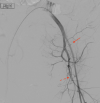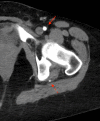Endovascular treatment of postpartum haemorrhage in a woman with genitourinary and vascular congenital malformations
- PMID: 33758047
- PMCID: PMC7993248
- DOI: 10.1136/bcr-2020-240608
Endovascular treatment of postpartum haemorrhage in a woman with genitourinary and vascular congenital malformations
Abstract
A 43-year-old woman presented with postpartum haemorrhage necessitating uterine artery embolisation. Prior to embolisation, angiography demonstrated the presence of a persistent sciatic artery (PSA). Due to the possibility of embolic particles inadvertently traveling to the lower extremity via this variant arterial pathway, care was taken to only embolise the uterine artery. PSAs are uncommon but important vascular pathways to screen for during pelvic intervention and are associated with other genitourinary anomalies.
Keywords: interventional radiology; obstetrics and gynaecology; radiology.
© BMJ Publishing Group Limited 2021. No commercial re-use. See rights and permissions. Published by BMJ.
Conflict of interest statement
Competing interests: None declared.
Figures







Similar articles
-
Uterine artery pseudoaneurysm with an anastomotic feeding vessel requiring repeat embolisation.BMJ Case Rep. 2018 Jul 11;2018:bcr2018224656. doi: 10.1136/bcr-2018-224656. BMJ Case Rep. 2018. PMID: 30002208 Free PMC article.
-
Aberrant ovarian artery arising from the common iliac artery: case report.Korean J Radiol. 2013 Jan-Feb;14(1):91-3. doi: 10.3348/kjr.2013.14.1.91. Epub 2012 Dec 28. Korean J Radiol. 2013. PMID: 23323036 Free PMC article.
-
Postpartum haemorrhage requiring embolisation of a hypertrophied round ligament artery.BMJ Case Rep. 2019 Aug 30;12(8):e230071. doi: 10.1136/bcr-2019-230071. BMJ Case Rep. 2019. PMID: 31473635 Free PMC article.
-
Extravasating uterine pseudoaneurysm: A rare cause of postpartum haemorrhage.J Obstet Gynaecol. 2017 May;37(4):416-420. doi: 10.1080/01443615.2016.1274292. Epub 2017 Feb 25. J Obstet Gynaecol. 2017. PMID: 28421908 Review.
-
Treatment Strategy for Persistent Sciatic Artery and Novel Classification Reflecting Anatomic Status.Eur J Vasc Endovasc Surg. 2016 Sep;52(3):360-9. doi: 10.1016/j.ejvs.2016.05.007. Epub 2016 Jun 29. Eur J Vasc Endovasc Surg. 2016. PMID: 27369291 Review.
References
Publication types
MeSH terms
LinkOut - more resources
Full Text Sources
Other Literature Sources
Research Materials
Miscellaneous
